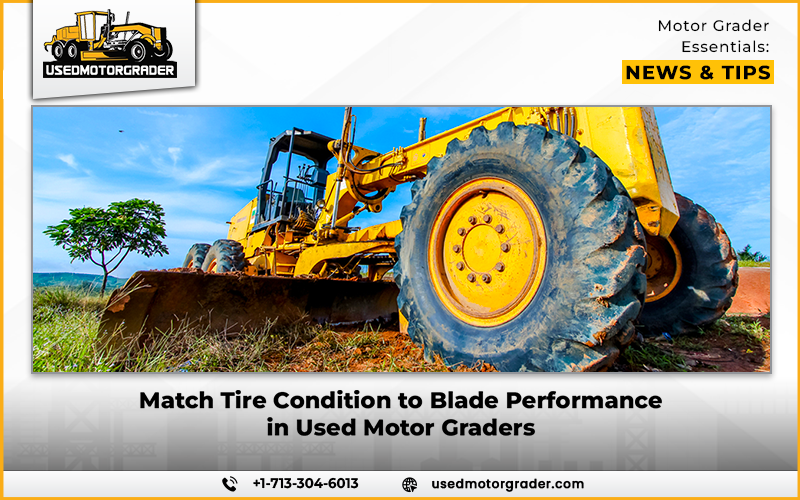The Overlooked Link Between Tires and Blade Work
Contractors mostly inspect the blade engine hydraulics and the blade when purchasing used motor graders. The actual use of the machine on the ground surface deserves equal attention. Since tires touch the ground only once, the grader works determine how well the blade operates. Blade performance depends strongly on tire health since few people recognize this connection. Not paying attention to tire health causes poor results, plus tired operators and longer machine stops, which reduce your profits.
Why Tire Condition Isn’t Just About Tread Depth
It seems simple to judge a motor grader tire based on its tread depth alone. The complete evaluation needs to consider more factors. You need to examine the rubber structure along with sidewall strength and tire age effects. Tires may appear in good condition, but their performance suffers from dry rot and aging durability problems. When the tread pattern remains visible, it does not necessarily mean that the rubber material will operate correctly on various ground types. Look for tire surface patterns and alignment issues that show the machine worked on harsh ground or with axle problems. The patterns on tire surfaces influence both how well the vehicle drives and how smooth the ground slopes appear.
How Uneven Tire Wear Affects Grading Precision
All blade stability depends on the quality of tires. When tires do not rest flat or show equal signs of wear, the blade cannot connect properly to the ground surface. The machine produces poor grading results while needing multiple passes to correct them. One tire with bad wear or softness will change the blade angle even when the machine is only slightly tipped. The machine will need longer adjustments and use more fuel while enduring greater strain. The amount of correction work you will need to perform on used motor graders depends on whether you see uneven tire wear during inspection.
Identifying Past Jobsite Influence Through Tire Patterns
The tire conditions show where the machine operated previously. A grader that only works on paved roads features different tire wear compared to machines used in demanding quarry operations or muddy construction jobs. The tire wear patterns of scuffing on the sidewalls, plus flat spots and fast tread loss, show how the machine handled rough ground and possible misuse by the operator. The signs help customers predict which machine parts have suffered stress and which jobs are most suitable for the machine.
Matching Tire Type to Intended Workload
Having different grader tire types available makes a difference, especially when you plan to push your used motor grader into demanding tasks. Radial tires provide smooth driving and conserve fuel better than other tires, but perform best on flat, smooth surfaces. Bias-ply tires handle rough terrain better because they can withstand harsh surfaces. Grader tires require different tread patterns depending on the surface. Wide-lug tires grip better in muddy areas, yet tighter treads fight off wear and tear on solid ground. The selection of used motor graders depends on what tasks you plan to give it, so choose based on known differences between tire models.
Blade Performance and Tire Inflation: A Balancing Act
Tires work best only if they maintain the right amount of air pressure. Blade performance depends directly on tire inflation since it controls how weight is distributed across the equipment and impacts traction. When tires are too inflated, they bounce on solid ground, which affects the blade stability. The soft ground absorbs the weight of underinflated tires, which causes the blade to drop lower than expected. Maintaining consistent air pressure in all tires becomes vital when operating a motor grader because it keeps the blade at its proper angle during continuous work. Make sure to check both the PSI reading and evidence of proper tire maintenance when inspecting the machine.
When to Factor Tire Replacement Into Total Ownership Cost
Tires represent the most expensive wear parts of a motor grader, and their condition determines the true worth of a used machine. You will face both visual and financial problems when you see four nearly bald or different tires side by side. Adding new tires to a brand-new machine quadruples the total purchasing expenses. The machine’s price will be set higher if its rubber tires are in good condition and of high quality. The evaluation of tire condition must be included in your machine cost evaluation process.
Effective Inspection Tips: What to Ask, What to Check
During inspection, you should inspect more than just tire treads. Before starting your walkaround, verify the codes on each tire indicate the appropriate age and check that all tires are from the same set and have matching tread depth. Look for damage on sidewalls that resemble bubbles or breaks. Request service documents or tire record logs if they exist. Make sure retread tires have strong bonds and appear the same in their wear patterns. Search for tire damage that happened from past excessive weight. A properly maintained set of tires shows that the grader was handled well and prompts confidence in the overall equipment’s health.


